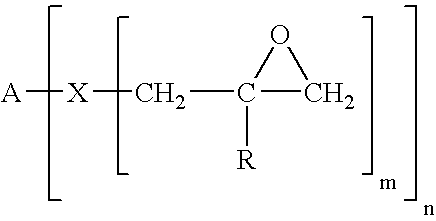Composite-forming method, composites formed thereby, and printed circuit boards incorporating them
a technology of composites and composite resins, which is applied in the field of composite forming methods, composite forming methods, printed circuit boards incorporating them, etc., can solve the problems of brittleness of cured epoxy resins, relatively high temperature required to dissolve polyphenylene, and less tough products obtained on curing these compositions
- Summary
- Abstract
- Description
- Claims
- Application Information
AI Technical Summary
Benefits of technology
Problems solved by technology
Method used
Image
Examples
examples 4-15
, COMPARATIVE EXAMPLES 3-10
[0085]These examples illustrate variation in curable composition viscosity as a function of solvent amount and poly(arylene ether) type and amount.
[0086]For Comparative Example 3 and Examples 4-15, the epoxy resin and the bifunctional poly(arylene ether)s are described above. Comparative Examples 4-11 used a different epoxy resin and different poly(arylene ether)s. The epoxy resin was a high purity bisphenol A diglycidyl ether obtained as D.E.R. 332 from Dow. The poly(arylene ether)s were acetic anhydride capped bifunctional poly(arylene ether)s (“PPE(Ac)2” in Table 3) having intrinsic viscosities of 0.06 and 0.12 deciliters per gram (in other words, the terminal hydroxy groups of the bifunctional poly(arylene ether)s had been converted to acetate esters). Compositions are presented in Table 3, where all component amounts are expressed in parts by weight.
[0087]Viscosity values, expressing in units of centipoise (cps), were measured at 23° C. and 50° C. usi...
examples 16-102
[0089]Results for solubility of monofunctional and bifunctional poly (arylene ether) are presented in Tables 4-12. The results show solubility of bifunctional (arylene ether) in toluene, methyl ethyl ketone, chloroform, and N,N-dimethylformamide. The bifunctional poly(arylene ether) is soluble up to 60 weight percent in toluene and methyl ethyl ketone up to 7 days. In contrast, 0.06 IV monofunctional poly(arylene ether) had an initial solubility up to 50 weight percent in methyl ethyl ketone, but formed a precipitate after 1 day. In some embodiments, methyl ethyl ketone may be preferred over toluene as solvent for the lamination process. Specifically, when the resin is cured with hot air, methyl ethyl ketone may be a preferred solvent. When the resin mixture is cured by infrared radiation, then a mixture of ketones and toluene is typically preferred. Bifunctional poly(arylene ether) is soluble up to 50 weight percent in chloroform up to 7 days. A 0.06 IV bifunctional poly (arylene e...
PUM
| Property | Measurement | Unit |
|---|---|---|
| temperature | aaaaa | aaaaa |
| polydispersity index | aaaaa | aaaaa |
| boiling point | aaaaa | aaaaa |
Abstract
Description
Claims
Application Information
 Login to View More
Login to View More - R&D
- Intellectual Property
- Life Sciences
- Materials
- Tech Scout
- Unparalleled Data Quality
- Higher Quality Content
- 60% Fewer Hallucinations
Browse by: Latest US Patents, China's latest patents, Technical Efficacy Thesaurus, Application Domain, Technology Topic, Popular Technical Reports.
© 2025 PatSnap. All rights reserved.Legal|Privacy policy|Modern Slavery Act Transparency Statement|Sitemap|About US| Contact US: help@patsnap.com



